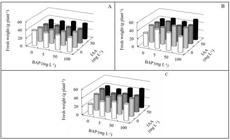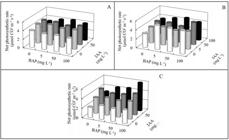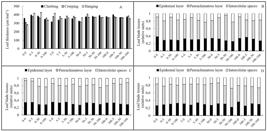ABSTRACT
Climbing Epipremnum aureum plants develop larger leaves than unsupported, hanging plants. This effect may be regarded, in part, as a thigmomorphogenic response, but gravimorphogenetic effect may also be involved, since polar auxin transport is known to be negatively affected in plants with horizontal or hanging stems, which may result in an altered hormone balance at the whole plant level. The present work was aimed at studying how exogenous auxins and cytokinins may influence growth of E. aureum rooted cuttings under different training systems. Rooted cuttings of E. aureum were cultivated either climbing on an upright wooden board or creeping on the glasshouse bench or hanging from a basket. All leaves of each plant were sprayed to run-off at sunset with four indole-3-acetic acid (IAA) doses 7 days after transplanting and one week later, with four benzylaminopurine (BAP) concentrations, rendering 16 hormone combination treatments. The application of IAA or BAP at 50 mg L-1 to creeping and hanging plants significantly promoted growth but, in climbing plants, a negative effect was generally observed. Changes in net assimilation and photosynthetic rates, together with modified allometric coefficients, accounted for these responses. The higher growth promotion by exogenous growth regulators observed in creeping or hanging plants compared to climbing plants, may be interpreted mostly as a gravimorphogenetic response.
Keywords:
auxin; citokinin; foliage plants; gravitropism; leaf growth; leaf anatomy; photosynthesis

 Thumbnail
Thumbnail
 Thumbnail
Thumbnail
 Thumbnail
Thumbnail


